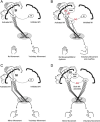A Reflection on Motor Overflow, Mirror Phenomena, Synkinesia and Entrainment
- PMID: 37772299
- PMCID: PMC10525069
- DOI: 10.1002/mdc3.13798
A Reflection on Motor Overflow, Mirror Phenomena, Synkinesia and Entrainment
Abstract
In patients with movement disorders, voluntary movements can sometimes be accompanied by unintentional muscle contractions in other body regions. In this review, we discuss clinical and pathophysiological aspects of several motor phenomena including mirror movements, dystonic overflow, synkinesia, entrainment and mirror dystonia, focusing on their similarities and differences. These phenomena share some common clinical and pathophysiological features, which often leads to confusion in their definition. However, they differ in several aspects, such as the body part showing the undesired movement, the type of this movement (identical or not to the intentional movement), the underlying neurological condition, and the role of primary motor areas, descending pathways and inhibitory circuits involved, suggesting that these are distinct phenomena. We summarize the main features of these fascinating clinical signs aiming to improve the clinical recognition and standardize the terminology in research studies. We also suggest that the term "mirror dystonia" may be not appropriate to describe this peculiar phenomenon which may be closer to dystonic overflow rather than to the classical mirror movements.
Keywords: entrainment; mirror dystonia; mirror movements; overflow; synkinesia.
© 2023 The Authors. Movement Disorders Clinical Practice published by Wiley Periodicals LLC on behalf of International Parkinson and Movement Disorder Society.
Figures

References
Publication types
LinkOut - more resources
Full Text Sources

